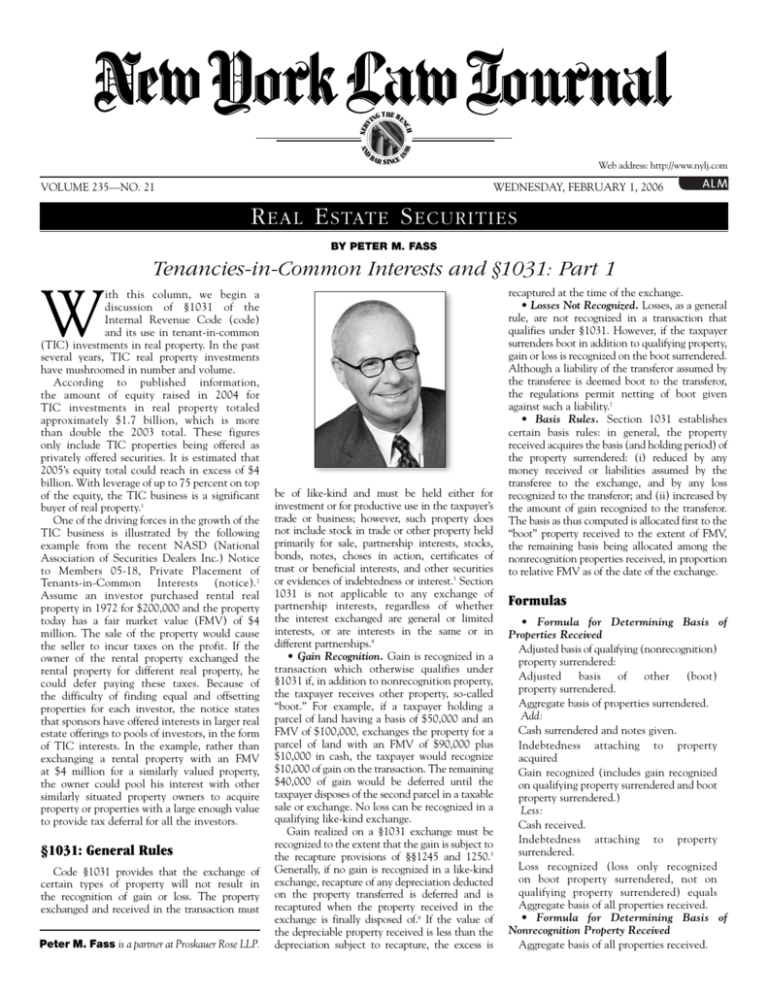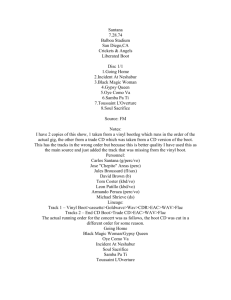
AND
88
8
SER
V
H
NC
THE BE
ING
BA
R SINCE 1
VOLUME 235—NO. 21
Web address: http://www.nylj.com
WEDNESDAY, FEBRUARY 1, 2006
R EAL E STATE S ECURITIES
BY PETER M. FASS
Tenancies-in-Common Interests and §1031: Part 1
W
ith this column, we begin a
discussion of §1031 of the
Internal Revenue Code (code)
and its use in tenant-in-common
(TIC) investments in real property. In the past
several years, TIC real property investments
have mushroomed in number and volume.
According to published information,
the amount of equity raised in 2004 for
TIC investments in real property totaled
approximately $1.7 billion, which is more
than double the 2003 total. These figures
only include TIC properties being offered as
privately offered securities. It is estimated that
2005’s equity total could reach in excess of $4
billion. With leverage of up to 75 percent on top
of the equity, the TIC business is a significant
buyer of real property.1
One of the driving forces in the growth of the
TIC business is illustrated by the following
example from the recent NASD (National
Association of Securities Dealers Inc.) Notice
to Members 05-18, Private Placement of
Tenants-in-Common Interests (notice).2
Assume an investor purchased rental real
property in 1972 for $200,000 and the property
today has a fair market value (FMV) of $4
million. The sale of the property would cause
the seller to incur taxes on the profit. If the
owner of the rental property exchanged the
rental property for different real property, he
could defer paying these taxes. Because of
the difficulty of finding equal and offsetting
properties for each investor, the notice states
that sponsors have offered interests in larger real
estate offerings to pools of investors, in the form
of TIC interests. In the example, rather than
exchanging a rental property with an FMV
at $4 million for a similarly valued property,
the owner could pool his interest with other
similarly situated property owners to acquire
property or properties with a large enough value
to provide tax deferral for all the investors.
§1031: General Rules
Code §1031 provides that the exchange of
certain types of property will not result in
the recognition of gain or loss. The property
exchanged and received in the transaction must
Peter M. Fass is a partner at Proskauer Rose LLP.
be of like-kind and must be held either for
investment or for productive use in the taxpayer’s
trade or business; however, such property does
not include stock in trade or other property held
primarily for sale, partnership interests, stocks,
bonds, notes, choses in action, certificates of
trust or beneficial interests, and other securities
or evidences of indebtedness or interest.3 Section
1031 is not applicable to any exchange of
partnership interests, regardless of whether
the interest exchanged are general or limited
interests, or are interests in the same or in
different partnerships.4
• Gain Recognition. Gain is recognized in a
transaction which otherwise qualifies under
§1031 if, in addition to nonrecognition property,
the taxpayer receives other property, so-called
“boot.” For example, if a taxpayer holding a
parcel of land having a basis of $50,000 and an
FMV of $100,000, exchanges the property for a
parcel of land with an FMV of $90,000 plus
$10,000 in cash, the taxpayer would recognize
$10,000 of gain on the transaction. The remaining
$40,000 of gain would be deferred until the
taxpayer disposes of the second parcel in a taxable
sale or exchange. No loss can be recognized in a
qualifying like-kind exchange.
Gain realized on a §1031 exchange must be
recognized to the extent that the gain is subject to
the recapture provisions of §§1245 and 1250.5
Generally, if no gain is recognized in a like-kind
exchange, recapture of any depreciation deducted
on the property transferred is deferred and is
recaptured when the property received in the
exchange is finally disposed of.6 If the value of
the depreciable property received is less than the
depreciation subject to recapture, the excess is
recaptured at the time of the exchange.
• Losses Not Recognized. Losses, as a general
rule, are not recognized in a transaction that
qualifies under §1031. However, if the taxpayer
surrenders boot in addition to qualifying property,
gain or loss is recognized on the boot surrendered.
Although a liability of the transferor assumed by
the transferee is deemed boot to the transferor,
the regulations permit netting of boot given
against such a liability.7
• Basis Rules. Section 1031 establishes
certain basis rules: in general, the property
received acquires the basis (and holding period) of
the property surrendered: (i) reduced by any
money received or liabilities assumed by the
transferee to the exchange, and by any loss
recognized to the transferor; and (ii) increased by
the amount of gain recognized to the transferor.
The basis as thus computed is allocated first to the
“boot” property received to the extent of FMV,
the remaining basis being allocated among the
nonrecognition properties received, in proportion
to relative FMV as of the date of the exchange.
Formulas
• Formula for Determining Basis of
Properties Received
Adjusted basis of qualifying (nonrecognition)
property surrendered:
Adjusted
basis
of
other
(boot)
property surrendered.
Aggregate basis of properties surrendered.
Add:
Cash surrendered and notes given.
Indebtedness attaching to property
acquired
Gain recognized (includes gain recognized
on qualifying property surrendered and boot
property surrendered.)
Less:
Cash received.
Indebtedness attaching to property
surrendered.
Loss recognized (loss only recognized
on boot property surrendered, not on
qualifying property surrendered) equals
Aggregate basis of all properties received.
• Formula for Determining Basis of
Nonrecognition Property Received
Aggregate basis of all properties received.
WEDNESDAY, FEBRUARY 1, 2006
NEW YORK LAW JOURNAL
Less:
FMV of other (boot) property received
equals
Basis of nonrecognition property received
(allocate on bases of relative FMV if more
than one property received.)
The holding period of the transferred
qualified property is tacked on to the
received qualified property’s holding
period. IRC §1223(a). There is no tacking
on any nonqualified property received in
an exchange.
The example in Table 1 illustrates a typical
two-party simultaneous §1031(a) exchange.
T surrenders a building (with an adjusted
basis of $2 million and an FMV of $8 million,
subject to a mortgage of $3 million), in
exchange for a building (with an FMV of
$8 million, subject to a mortgage of $4
million) and marketable securities with
an FMV of $1 million.
Table 1
1. Computation of Realized Gain
FMV of nonrecognition property received
FMV of boot property received
Indebtedness attaching to property transferred
Total consideration received
Less:
Adjusted basis of property surrendered
Indebtedness attaching to property received
Gain realized
$8,000,000
$1,000,000
$3,000,000
$12,000,000
$2,000,000
$4,000,000
$6,000,000
2. Computation of Boot Received
Indebtedness attaching to property surrendered
$3,000,000
Less:
Indebtedness attaching to property received
Boot received against which netting permitted
FMV of boot property received
Boot received
$4,000,000
-0$1,000,000
$1,000,000
Boot
3. Computation of Gain Recognized
mortgage transferred over the mortgage
received is treated as boot.10
Example. T transfers property with an
adjusted basis of $2 million and receives
$500,000 in cash and like-kind property with
an FMV of $3.5 million. The transferred
property has a $1 million mortgage and the
property received is subject to an $800,000
mortgage. The boot is $700,000 ($500,000 in
cash, plus the $1 million mortgage less the
$800,000 mortgage).
Example. Assume T transfers property with
an adjusted basis of $2 million and pays
$500,000 in cash for like-kind property with
an FMV of $3.5 million. The transferred
property is subject to a $1 million mortgage
and the property received is subject to a
$400,000 mortgage. The boot received by T is
$100,000 ($1 million transferred mortgage,
less the $400,000 mortgage on the property
received, less the $500,000 cash paid).
Generally, if mortgaged property is
transferred in return for cash and property
subject to a mortgage that is greater than the
one transferred the cash received cannot be
offset by the excess of the mortgage assumed.11
Example. T transfers property with a $2
million adjusted basis and receives $500,000
in cash and like-kind property with a $3.5
million FMV. The transferred property is
subject to a $600,000 mortgage, and the
property received is subject to a $900,000
mortgage. The boot is $500,000.
Closing and brokerage fees paid in an
exchange is treated as cash paid which
reduces any boot received.12
• Boot. If cash or other nonqualifying
property—“boot”—is received in what is Gain recognized
otherwise a like-kind exchange, the realized (lesser of gain realized or boot received)
$1,000,000
gain is recognized, but only as to the cash plus
the FMV of the nonqualifying property. But if 4. Computation of Basis of Properties Received
boot is received and a loss incurred on the
qualified property being transferred, the loss Adjusted basis of nonrecognition
property surrendered
$2,000,000
is not recognized.
$2,000,000
If the value of the qualified property and Aggregate basis of properties surrendered
boot received is less than the realized gain Add:
on the property transferred, the recognized
$4,000,000
gain cannot exceed the value of the boot Indebtedness attaching to property acquired
8
Gain
Recognized
$1,000,000
received. But if more boot is received than
$7,000,000 The Future
realized gain, the entire realized gain is
recognized. The basis of the property received Less:
The next column will continue the
equals the basis of the property transferred, Indebtedness attaching to property surrendered
($3,000,000) discussion of the general rules of
reduced by the cash received and increased by
Aggregate basis of all properties received
$4,000,000 §1031 including pre- and post-exchange
the gain recognized.
refinancings of debt on exchanged property,
Example: T transfers vacant land held for
investment to X. T brought the land for 5. Computation of Basis of Nonrecognition Property Received the holding period of real property before
the exchange related party exchanges, and
$150,000. X gives T $70,000 in cash and Aggregate basis of all property received
$4,000,000 multiparty exchange.
vacant land with an FMV of $90,000. T has
a realized gain of $10,000 all of which is Less:
••••••••••••••• •••••••••••••••
recognized since the boot ($70,000 of FMV of boot property received
($1,000,000)
1. See generally, Napoli, TIC Business Booms (Real
cash) received is more than the realized Basis of nonrecognition property received
$3,000,000 Estate Forum, February 2005) at 33-44.
gain ($160,000-$150,000). T’s basis in
2. NASD Notice to Members 05-18 (March 2, 2005)
the received vacant land is $90,000, Source: Peter M. Fass
available at NASDR.com under Notices to Members.
3. IRC §1031 has been in the code since 1921, originalcomputed in Table 2:
ly §202 of the code.
• Treatment of Liabilities. When mortgaged
Table 2
4. Reg. §1.1031(a)-1(a)(1).
property is exchanged, the amount of the
5. See, IRC §§1245(b)(4) and 1250(d)(4).
Basis of vacant land exchanged
$150,000
mortgage assumed by the transferee (or if the
6. Reg. §1.1031(d)-1(b), Example.
7. See, Reg. §1.1031(b)-1(c).
transferor was not personally liable, the amount
Less: Cash received
70,000
8. Reg. §1.1031(b)-1(a).
$80,000
of the mortgage to which the property is subject)
9. Reg. §1.1031(b)-1(c).
9
is treated as cash that was received.
10. Reg. §1.1031(b)-1(c). Note that the excess of mortgage
Plus: Gain recognized
10,000
Example. T transfers property with an
transferred over the mortgage received is reduced by any cash
Basis of vacant land received
$90,000
paid. Reg. §1.1031(d)(2), Example 2(c).
adjusted basis of $2 million and receives
11. Reg. §1.1031(d)(2), Example 2(c).
Source: Peter M. Fass
$500,000 in cash and like-kind property with an
12. Rev. Rul. 72-456, 1972-2 C.B. 468.
FMV of $3.5 million. The property T transfers
is subject to a $1 million mortgage. The boot
This article is reprinted with permission from the February 1, 2006 edition of the NEW YORK LAW JOURNAL. ©
2006 ALM Properties, Inc. All rights reserved. Further duplication without permission is prohibited. For informaequals $1.5 million ($500,000 in cash plus the
tion, contact ALM Reprint Department at 800-888-8300 x6111 or visit www.almreprints.com. #070-04-06-0010
$1 million mortgage).
To calculate the amount of cash received
when both properties in the exchange are
mortgaged, you net the mortgage on the
property received against the mortgage on
the transferred property. Only the excess of the
•









